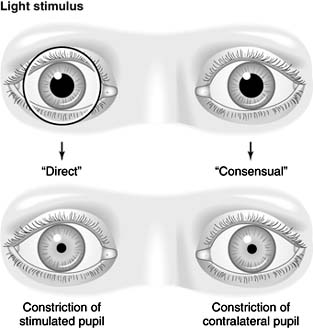
In addition, you need to know that the lesion can affect not just the retina, the optic nerve, the chiasm, the tract, but also the pretectal nuclei. It's not an afferent disease or relative to the fellow eye, you can't detect. So the absence of the RAPD means you either have no D, no defect is present, or it's not a defect in the pupil pathway. Relative to the fellow eye, you don't detect it. But because it's bilateral, you don't have the R. They have a defect in their pupil pathway on the afferent side. If you have bilateral and symmetric disease, then both pupils will be equally affected and you will not be able to detect an RAPD even though they have an APD. So you could have no RAPD and have real organic vision loss, either from a lesion anterior to the pupil pathway (cataract, glasses, cornea), or posterior to the pupil pathway (behind the optic tract). In addition anything in front of the geniculate body through radiations in the cortex also will not produce an RAPD because this is posterior to the pupil pathway. So anything in front of the retinal ganglion cell: cataract, cornea, glasses, tear film, that doesn't affect the pupil pathway because that is in front of the pupil pathway. It could be a problem in the afferent pathway but not in the pupil.
#EDINGER WESTPHAL NUCLEUS BLOWN PUPIL HOW TO#
Or you didn't detect it properly because you don't know how to do the test. Either the defect is not present there is nothing wrong with this person. So let's just give these examples so you can see why someone would have no RAPD.

Or there is no R relative to the fellow eye. Or you have a defect in the pupil pathway, but it's not on the afferent side. And vice versa, if we have no RAPD, that means we have either no defect or you have a defect but it is not in the pupil pathway. That means we have a defect somewhere in the pupil pathway. The relative afferent pupillary defect is a sign that there is a defect in the pupil pathway on the afferent side. That sign RAPD, tells us that we have an APD. Because now the direct response in the left eye is less than the consensual response in the right. When we see that, that indicates there is a defect in the pupil path in the afferent side relative to the fellow eye. But if there is damage to the left pupillary pathway, when we swing the light from the right to the left, both pupils will dilate. If we swing the light from the right eye, to the left eye, if both pupils are normal and the afferent system is intact, nothing will happen. So both pupils will constrict when we shine the light because there is a direct response, D, and a consensual response, C. This is the direct response and because of the pre-tectal neuron connecting both Edinger-Westphal nucleuses, the other pupil will constrict, the left pupil. So here are the pupils and if we shine the light on the pupil, in this case the right pupil, both pupils will constrict to light. So let's just schematically diagram this out. And because the pre-tectal nuclei innervate both Edinger-Westphal nuclei, we have a consensual response in the fellow eye. So if we have a defect in the pupil pathway of the afferent side, we can detect this defect by comparing the light response in both the eye that receives the light, which is the direct response. And the efferent pathway begins with the Edinger-Westphal nucleus and then is carried on cranial nerve 3 to the cilliary gangilion. And before getting to the lateral geniculate body, the pretectal neuron comes off the optic tract and then it travels to the efferent pathway. Then the pupil pathway carries the light reflex down the optic nerve, down the optic tract. So this is just a schematic drawing demonstrating that the retina is where the light first hits the afferent pathway for the pupil. In order for you to know what an RAPD is, you need to know a little bit about the anatomy of the afferent pathway for the pupil and so we are just going to cover that right now. Its detected as a relative afferent pupillary defect because it is the relativity to the fellow eye that defines the RAPD. We are not going to be talking about the efferents, we are only going to be talking about afferent. The efferent fiber for the pupil is the sympathetics and the parasympathetics that's carried by Cranial Nerve 3 for the parasympathetics and the Horner's syndrome is what you get with a sympathetic lesion. The efferent side is away from the brain. The afferent side is the sensory going towards the brain. And RAPD means you have a defect in the pupil pathway, but not on the efferent side, the afferent side. So today we are going to be talking about RAPD.

Lee, MD, Chairman, Department of Ophthalmology, The Methodist Hospital, Houston, TX Professor of Ophthalmology, Weill Cornell Medicine Varsha Sathappan, Baylor College of Medicine Class of 2022ĭr. RAPD_Relative_Afferent_Pupillary_Defect_Marcus-Gunn_pupilĪndrew G.


 0 kommentar(er)
0 kommentar(er)
